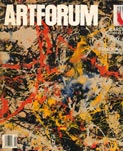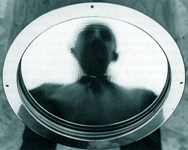Artforum - april 1999
from ARTFORUM – April 1999 - page 129
PAOLO MONTI
GALLERIA ARCO DI RAB
by Massimo Carboni
 The work of Roman artist Paolo Monti can be divided into two
distinct but closely interconnected conceptual and methodological
categories. On the one hand, the artist has created a body work
about money (both its symbolic and material aspects) in which he
explores the fetishism of value. Then there are his investigations
into scientific epistemological processes, carried out through
technological arrangements that isolate problems of perception and
relationships between subject and object, identity and otherness.
Some works have even incorporated elements from both approaches, as
in Immagine di dollaro (Dollar Image; first exhibited in 1989), in
which a cutout of George Washington from a dollar bill was placed
between sheets of chemically treated glass. When the resulting slide
was projected, the chemical solution, activated by the heat from the
projector light, slowly corroded the paper, subjecting the image of
the dollar-bill was icon to a gradual disintegration. This poetic
attention to changes of state, to controlled yet dynamic processes
(typical of the second category), was fully evident in
de-localizzazioni (de-localizations), 1998, the installation piece
presented in Monti’s recent show.
The work of Roman artist Paolo Monti can be divided into two
distinct but closely interconnected conceptual and methodological
categories. On the one hand, the artist has created a body work
about money (both its symbolic and material aspects) in which he
explores the fetishism of value. Then there are his investigations
into scientific epistemological processes, carried out through
technological arrangements that isolate problems of perception and
relationships between subject and object, identity and otherness.
Some works have even incorporated elements from both approaches, as
in Immagine di dollaro (Dollar Image; first exhibited in 1989), in
which a cutout of George Washington from a dollar bill was placed
between sheets of chemically treated glass. When the resulting slide
was projected, the chemical solution, activated by the heat from the
projector light, slowly corroded the paper, subjecting the image of
the dollar-bill was icon to a gradual disintegration. This poetic
attention to changes of state, to controlled yet dynamic processes
(typical of the second category), was fully evident in
de-localizzazioni (de-localizations), 1998, the installation piece
presented in Monti’s recent show.
In one room of the gallery, viewers could walk up to a block,
polycarbon plate framed in thick steel. A miniature television
camera hidden behind the black surface recorded whoever (or
whatever) was in front of it, instantly transmitting the image to an
analyzer that broke it down according the angle of the light. Almost
instantaneously, the altered image –not a “realistic” representation
but a set of chromatic variations of light and shadow- showed up on
a monitor placed in an adjoining space in the gallery.
However, anyone pausing for a few moments in front of the framed
black matter activated sensors that released mercury container in a
vitrous chamber within the thick frame. As the level of mercury
rose, it interacted with the polycarbon to form a mirror like surface
in which, as the black substance disappeared, the viewer could
gradually see his or her reflection. At the same time, the rising
mercury little by little submerged the micro camera, so that as soon
as the viewer’s likeness appeared before him or her, the chromatic
image slowly disappeared from the monitor.
This symbolic play between identity and otherness seemed to function
a san interrogation into the very meaning of subjectivity. When
another viewer saw me (on the monitor), I didn’t see myself (on the
sheet of glass). I eluded myself, only to allow myself to be caught
by someone else. Conversely, I “found myself” only to the extent
that others lost me. The profundity of the work lies in this
alternation, which has decisive existential reverberations. After a
while the mercury fell, once again leaving the visual field free for
the miniature television camera, which had previously been
obstructed by the liquid; and, beginning from the top down, the
image of the observer in front of the sheet of glass reappeared on
the monitor. It was as if the complex technology that lay behind the
operation of this piece contributed to freeing images from the
reality they were supposed to reflect. Images migrated from one
surface to the other, newly autonomous from their “model”.
Massimo Carboni
Translated from the Italian by Marguerite Shore
 PAOLO
MONTI
PAOLO
MONTI
GALLERIA ARCO DI RAB
by Massimo Carboni
in ARTFORUM – April 1999 - page 129

